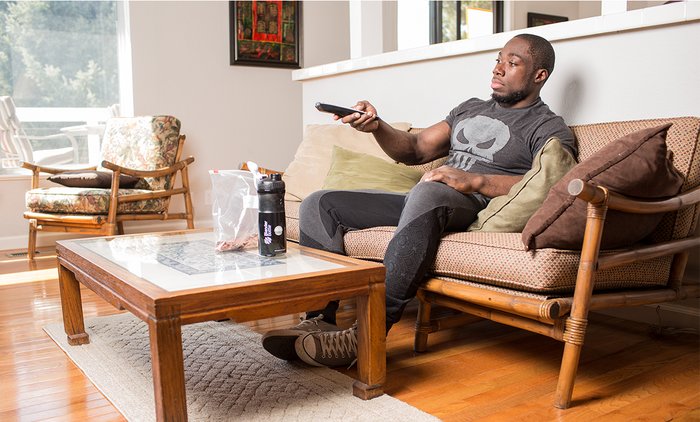You've probably heard warnings about how you can get a condition called venous thromboembolism (VTE), commonly known as deep-vein thrombosis, from staying glued to your seat during a long flight. It turns out you can get VTE from something much closer to home: Watching TV—or any kind of screen—for long periods of time. Yes, that's right, you can get it from binge watching. Luckily, you're in such good shape you can stretch out on the sofa and watch the entire first season of Stranger Things without risk, right? Not so much.
Venous thromboembolism is no joke. When a blood clot forms deep in your body, usually in your leg or thigh, from lengthy inactivity, it can cause your legs to swell, feel painful or tender, and turn red. Worst case, the blood clot can break free, travel to your lungs, become a pulmonary embolism, and result in death.

A new study of VTE is based on an analysis of 299,767 "person years"—that's almost 2-1/2 billion hours—of TV watching.[1] Researchers looked to see how many incidents of VTE showed up after all that time spent immobile in front of a screen. The overall number of VTE events was only 691, and the participants tended to be on the older side, from 45-64 years old.
Even so, the results were surprising. Those who demonstrated some degree of obesity and watched TV "very often" were at almost twice the risk (1.71) to experience thrombosis as those who watched TV "never or seldom." But here's the kicker: Participants who were physically active and watched their weight didn't lower their risk of VTE. In fact, they raised it from 1.71 to 1.8 times the risk. The determining factor was how long they remain parked in front of the screen.
There are two lessons you can learn from this research. The first is that even if you're in very good shape, you're still at risk for a VTE event when you watch a screen—any kind of screen—for hours on end without getting up and moving around.
The second lesson is that, for the sake of your overall health, "getting up and moving around" shouldn't include heading for the kitchen and loading up on more snacks for the next episode. But you knew that, right?
References
- Kubota, Y., Cushman, M., Zakai, N., Rosamond, W. D., & Folsom, A. R. (2017). TV Viewing and Incident Venous Thromboembolism: the Atherosclerotic Risk in Communities Study.

